LINCOLN MKC 2018 Owner's Manual
Manufacturer: LINCOLN, Model Year: 2018, Model line: MKC, Model: LINCOLN MKC 2018Pages: 571, PDF Size: 4.39 MB
Page 21 of 571

Direction indicators. See DirectionIndicators (page 92). High beam.See Lighting Control (page 87).
A
Instrument cluster. See Gauges(page 103). See Warning Lampsand Indicators (page 104).
B
Wiper lever. See Wipers andWashers (page 83).C
Information and entertainmentdisplay. See SYNC™ 3 (page 368).D
Audio unit. See Audio Unit (page365).E
Hazard warning flasher switch.See Hazard Flashers (page 254).F
Parking aid switch. See ParkingAids (page 197).G
Heated rear window switch. SeeHeated Windows and Mirrors(page 136).
H
Climate controls. See ClimateControl (page 133).I
Start button. See Keyless Starting(page 156).J
Entertainment, navigation andphone.K
Voice control. See Voice Control(page 81).L
Horn.M
Steering wheel adjustment. SeeAdjusting the Steering Wheel(page 79).
N
Cruise control switches. SeeUsing Cruise Control (page 209).O
Information display controls. SeeInformation Display Control (page82).
P
Parking brake. See ElectricParking Brake (page 187).Q
Lighting control. See LightingControl (page 87). InstrumentLighting Dimmer. See InstrumentLighting Dimmer (page 89).
R
18
MKC (TME) Canada/United States of America, JJ7J 19A321 AA enUSA, Edition date: 201707, Second Printing
At a Glance
Page 22 of 571
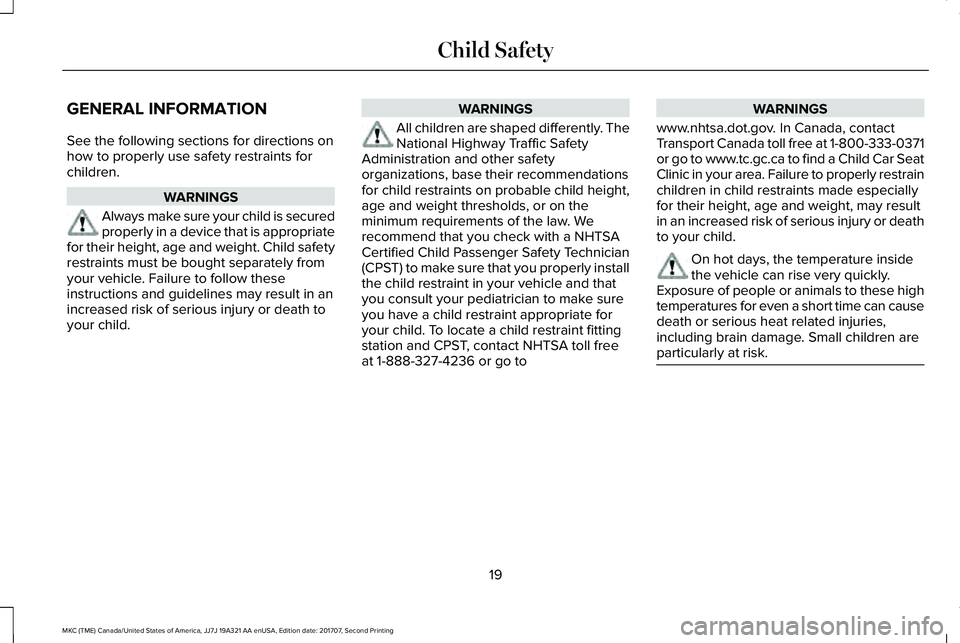
GENERAL INFORMATION
See the following sections for directions onhow to properly use safety restraints forchildren.
WARNINGS
Always make sure your child is securedproperly in a device that is appropriatefor their height, age and weight. Child safetyrestraints must be bought separately fromyour vehicle. Failure to follow theseinstructions and guidelines may result in anincreased risk of serious injury or death toyour child.
WARNINGS
All children are shaped differently. TheNational Highway Traffic SafetyAdministration and other safetyorganizations, base their recommendationsfor child restraints on probable child height,age and weight thresholds, or on theminimum requirements of the law. Werecommend that you check with a NHTSACertified Child Passenger Safety Technician(CPST) to make sure that you properly installthe child restraint in your vehicle and thatyou consult your pediatrician to make sureyou have a child restraint appropriate foryour child. To locate a child restraint fittingstation and CPST, contact NHTSA toll freeat 1-888-327-4236 or go to
WARNINGS
www.nhtsa.dot.gov. In Canada, contactTransport Canada toll free at 1-800-333-0371or go to www.tc.gc.ca to find a Child Car SeatClinic in your area. Failure to properly restrainchildren in child restraints made especiallyfor their height, age and weight, may resultin an increased risk of serious injury or deathto your child.
On hot days, the temperature insidethe vehicle can rise very quickly.Exposure of people or animals to these hightemperatures for even a short time can causedeath or serious heat related injuries,including brain damage. Small children areparticularly at risk.
19
MKC (TME) Canada/United States of America, JJ7J 19A321 AA enUSA, Edition date: 201707, Second Printing
Child Safety
Page 23 of 571

Recommendations for Safety Restraints for Children
Recommended restraint typeChild size, height, weight, or ageChild
Use a child safety seat (sometimes called aninfant carrier, convertible seat, or toddlerseat).
Children weighing 40 lb (18 kg) or less (generally age four oryounger).Infants or toddlers
Use a belt-positioning booster seat.
Children who have outgrown or no longer properly fit in a childsafety seat (generally children who are less than 4 ft. 9 in. (1.45 m)tall, are greater than age four and less than age 12, and between40 lb (18 kg) and 80 lb (36 kg) and upward to 100 lb (45 kg) ifrecommended by your child restraint manufacturer).
Small children
Use a vehicle safety belt having the lap beltsnug and low across the hips, shoulder beltcentered across the shoulder and chest, andseatback upright.
Children who have outgrown or no longer properly fit in a belt-positioning booster seat (generally children who are at least 4 ft.9 in. (1.45 m) tall or greater than 80 lb (36 kg) or 100 lb (45 kg) ifrecommended by child restraint manufacturer).
Larger children
20
MKC (TME) Canada/United States of America, JJ7J 19A321 AA enUSA, Edition date: 201707, Second Printing
Child Safety
Page 24 of 571
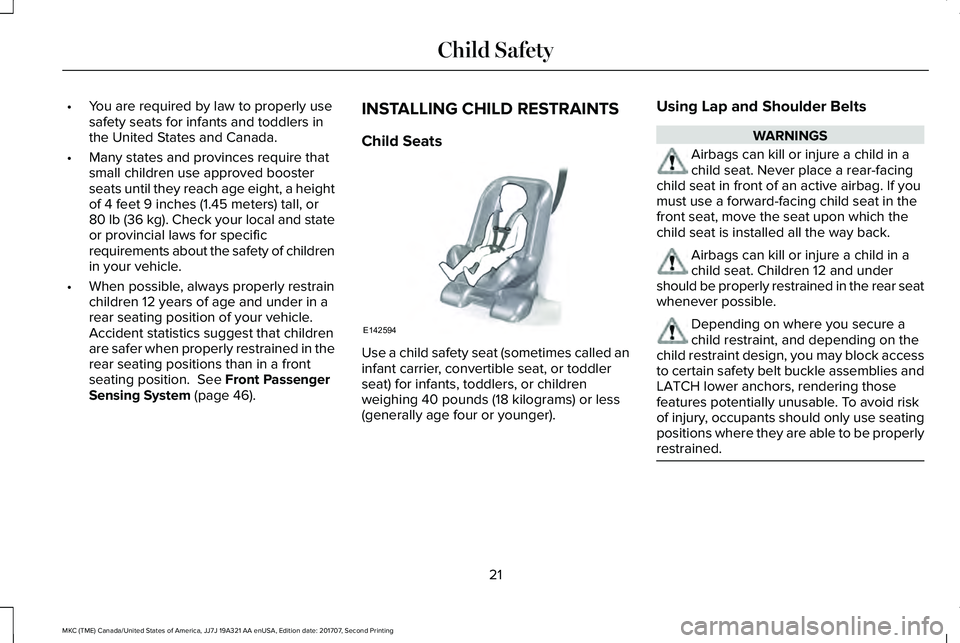
•You are required by law to properly usesafety seats for infants and toddlers inthe United States and Canada.
•Many states and provinces require thatsmall children use approved boosterseats until they reach age eight, a heightof 4 feet 9 inches (1.45 meters) tall, or80 lb (36 kg). Check your local and stateor provincial laws for specificrequirements about the safety of childrenin your vehicle.
•When possible, always properly restrainchildren 12 years of age and under in arear seating position of your vehicle.Accident statistics suggest that childrenare safer when properly restrained in therear seating positions than in a frontseating position. See Front PassengerSensing System (page 46).
INSTALLING CHILD RESTRAINTS
Child Seats
Use a child safety seat (sometimes called aninfant carrier, convertible seat, or toddlerseat) for infants, toddlers, or childrenweighing 40 pounds (18 kilograms) or less(generally age four or younger).
Using Lap and Shoulder Belts
WARNINGS
Airbags can kill or injure a child in achild seat. Never place a rear-facingchild seat in front of an active airbag. If youmust use a forward-facing child seat in thefront seat, move the seat upon which thechild seat is installed all the way back.
Airbags can kill or injure a child in achild seat. Children 12 and undershould be properly restrained in the rear seatwhenever possible.
Depending on where you secure achild restraint, and depending on thechild restraint design, you may block accessto certain safety belt buckle assemblies andLATCH lower anchors, rendering thosefeatures potentially unusable. To avoid riskof injury, occupants should only use seatingpositions where they are able to be properlyrestrained.
21
MKC (TME) Canada/United States of America, JJ7J 19A321 AA enUSA, Edition date: 201707, Second Printing
Child SafetyE142594
Page 25 of 571
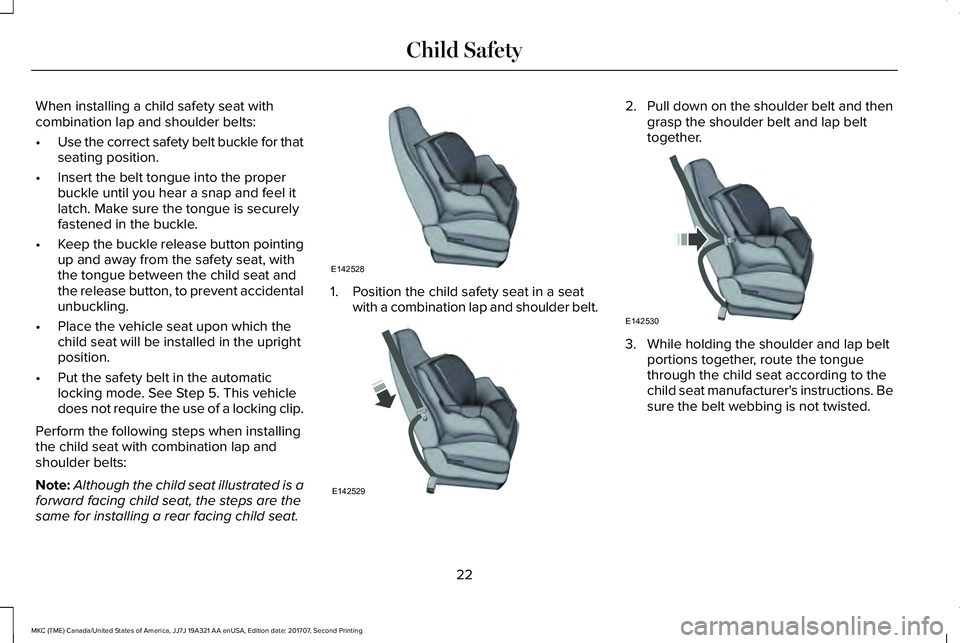
When installing a child safety seat withcombination lap and shoulder belts:
•Use the correct safety belt buckle for thatseating position.
•Insert the belt tongue into the properbuckle until you hear a snap and feel itlatch. Make sure the tongue is securelyfastened in the buckle.
•Keep the buckle release button pointingup and away from the safety seat, withthe tongue between the child seat andthe release button, to prevent accidentalunbuckling.
•Place the vehicle seat upon which thechild seat will be installed in the uprightposition.
•Put the safety belt in the automaticlocking mode. See Step 5. This vehicledoes not require the use of a locking clip.
Perform the following steps when installingthe child seat with combination lap andshoulder belts:
Note:Although the child seat illustrated is aforward facing child seat, the steps are thesame for installing a rear facing child seat.
1. Position the child safety seat in a seatwith a combination lap and shoulder belt.
2.Pull down on the shoulder belt and thengrasp the shoulder belt and lap belttogether.
3. While holding the shoulder and lap beltportions together, route the tonguethrough the child seat according to thechild seat manufacturer's instructions. Besure the belt webbing is not twisted.
22
MKC (TME) Canada/United States of America, JJ7J 19A321 AA enUSA, Edition date: 201707, Second Printing
Child SafetyE142528 E142529 E142530
Page 26 of 571
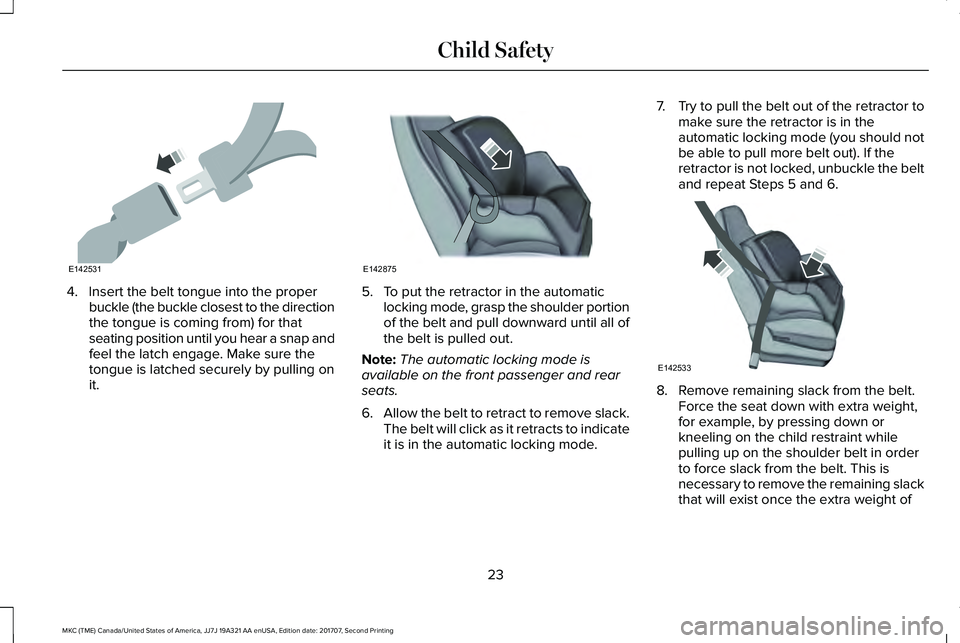
4. Insert the belt tongue into the properbuckle (the buckle closest to the directionthe tongue is coming from) for thatseating position until you hear a snap andfeel the latch engage. Make sure thetongue is latched securely by pulling onit.
5. To put the retractor in the automaticlocking mode, grasp the shoulder portionof the belt and pull downward until all ofthe belt is pulled out.
Note:The automatic locking mode isavailable on the front passenger and rearseats.
6.Allow the belt to retract to remove slack.The belt will click as it retracts to indicateit is in the automatic locking mode.
7.Try to pull the belt out of the retractor tomake sure the retractor is in theautomatic locking mode (you should notbe able to pull more belt out). If theretractor is not locked, unbuckle the beltand repeat Steps 5 and 6.
8. Remove remaining slack from the belt.Force the seat down with extra weight,for example, by pressing down orkneeling on the child restraint whilepulling up on the shoulder belt in orderto force slack from the belt. This isnecessary to remove the remaining slackthat will exist once the extra weight of
23
MKC (TME) Canada/United States of America, JJ7J 19A321 AA enUSA, Edition date: 201707, Second Printing
Child SafetyE142531 E142875 E142533
Page 27 of 571
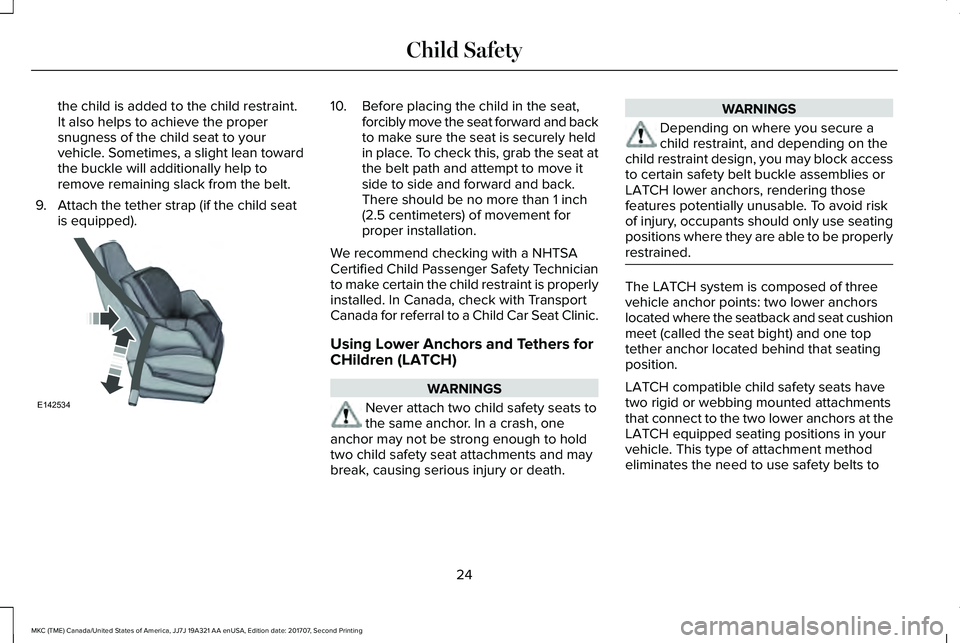
the child is added to the child restraint.It also helps to achieve the propersnugness of the child seat to yourvehicle. Sometimes, a slight lean towardthe buckle will additionally help toremove remaining slack from the belt.
9. Attach the tether strap (if the child seatis equipped).
10. Before placing the child in the seat,forcibly move the seat forward and backto make sure the seat is securely heldin place. To check this, grab the seat atthe belt path and attempt to move itside to side and forward and back.There should be no more than 1 inch(2.5 centimeters) of movement forproper installation.
We recommend checking with a NHTSACertified Child Passenger Safety Technicianto make certain the child restraint is properlyinstalled. In Canada, check with TransportCanada for referral to a Child Car Seat Clinic.
Using Lower Anchors and Tethers forCHildren (LATCH)
WARNINGS
Never attach two child safety seats tothe same anchor. In a crash, oneanchor may not be strong enough to holdtwo child safety seat attachments and maybreak, causing serious injury or death.
WARNINGS
Depending on where you secure achild restraint, and depending on thechild restraint design, you may block accessto certain safety belt buckle assemblies orLATCH lower anchors, rendering thosefeatures potentially unusable. To avoid riskof injury, occupants should only use seatingpositions where they are able to be properlyrestrained.
The LATCH system is composed of threevehicle anchor points: two lower anchorslocated where the seatback and seat cushionmeet (called the seat bight) and one toptether anchor located behind that seatingposition.
LATCH compatible child safety seats havetwo rigid or webbing mounted attachmentsthat connect to the two lower anchors at theLATCH equipped seating positions in yourvehicle. This type of attachment methodeliminates the need to use safety belts to
24
MKC (TME) Canada/United States of America, JJ7J 19A321 AA enUSA, Edition date: 201707, Second Printing
Child SafetyE142534
Page 28 of 571
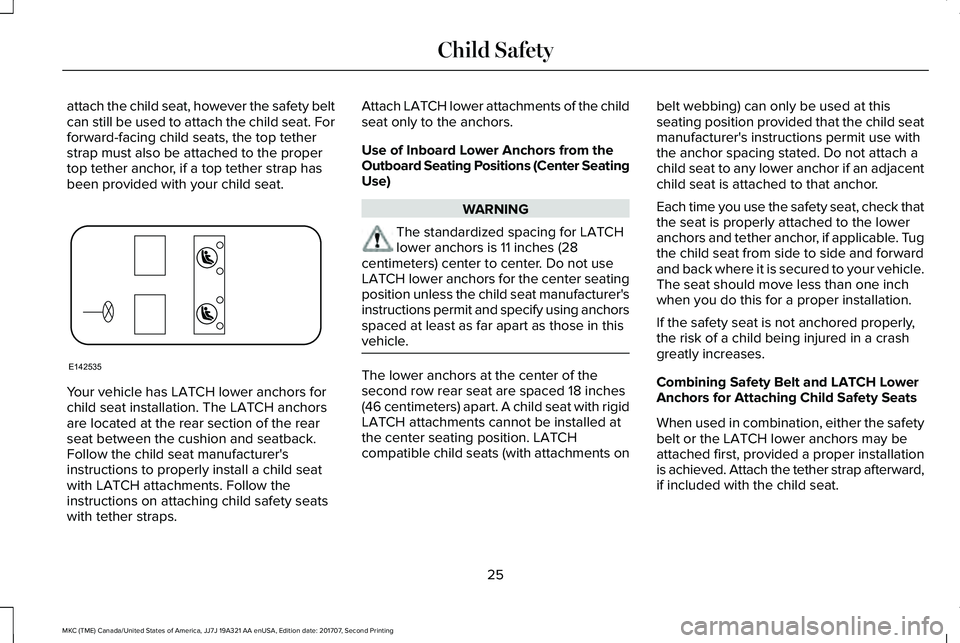
attach the child seat, however the safety beltcan still be used to attach the child seat. Forforward-facing child seats, the top tetherstrap must also be attached to the propertop tether anchor, if a top tether strap hasbeen provided with your child seat.
Your vehicle has LATCH lower anchors forchild seat installation. The LATCH anchorsare located at the rear section of the rearseat between the cushion and seatback.Follow the child seat manufacturer'sinstructions to properly install a child seatwith LATCH attachments. Follow theinstructions on attaching child safety seatswith tether straps.
Attach LATCH lower attachments of the childseat only to the anchors.
Use of Inboard Lower Anchors from theOutboard Seating Positions (Center SeatingUse)
WARNING
The standardized spacing for LATCHlower anchors is 11 inches (28centimeters) center to center. Do not useLATCH lower anchors for the center seatingposition unless the child seat manufacturer'sinstructions permit and specify using anchorsspaced at least as far apart as those in thisvehicle.
The lower anchors at the center of thesecond row rear seat are spaced 18 inches(46 centimeters) apart. A child seat with rigidLATCH attachments cannot be installed atthe center seating position. LATCHcompatible child seats (with attachments on
belt webbing) can only be used at thisseating position provided that the child seatmanufacturer's instructions permit use withthe anchor spacing stated. Do not attach achild seat to any lower anchor if an adjacentchild seat is attached to that anchor.
Each time you use the safety seat, check thatthe seat is properly attached to the loweranchors and tether anchor, if applicable. Tugthe child seat from side to side and forwardand back where it is secured to your vehicle.The seat should move less than one inchwhen you do this for a proper installation.
If the safety seat is not anchored properly,the risk of a child being injured in a crashgreatly increases.
Combining Safety Belt and LATCH LowerAnchors for Attaching Child Safety Seats
When used in combination, either the safetybelt or the LATCH lower anchors may beattached first, provided a proper installationis achieved. Attach the tether strap afterward,if included with the child seat.
25
MKC (TME) Canada/United States of America, JJ7J 19A321 AA enUSA, Edition date: 201707, Second Printing
Child SafetyE142535
Page 29 of 571
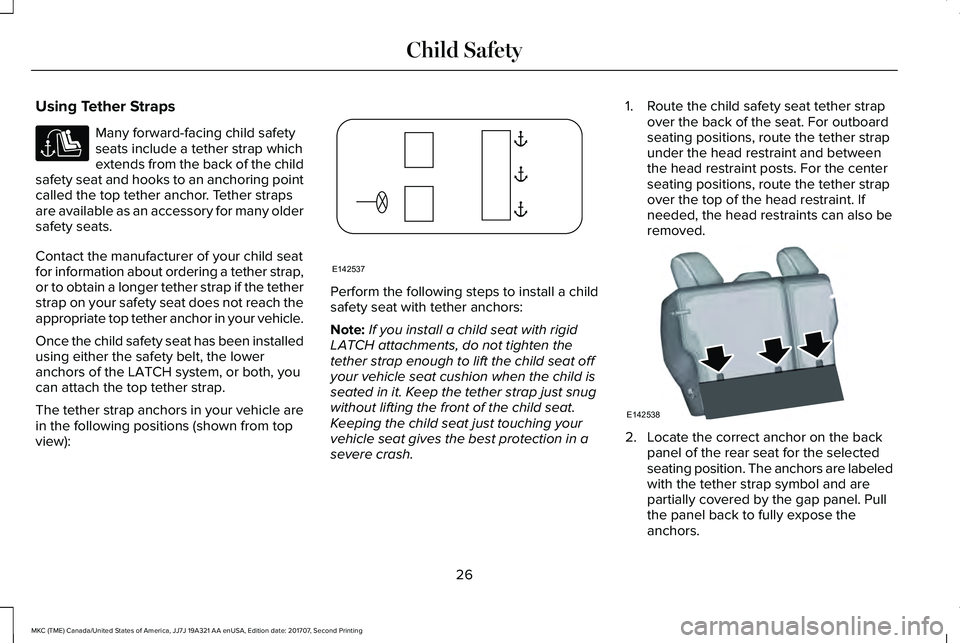
Using Tether Straps
Many forward-facing child safetyseats include a tether strap whichextends from the back of the childsafety seat and hooks to an anchoring pointcalled the top tether anchor. Tether strapsare available as an accessory for many oldersafety seats.
Contact the manufacturer of your child seatfor information about ordering a tether strap,or to obtain a longer tether strap if the tetherstrap on your safety seat does not reach theappropriate top tether anchor in your vehicle.
Once the child safety seat has been installedusing either the safety belt, the loweranchors of the LATCH system, or both, youcan attach the top tether strap.
The tether strap anchors in your vehicle arein the following positions (shown from topview):
Perform the following steps to install a childsafety seat with tether anchors:
Note:If you install a child seat with rigidLATCH attachments, do not tighten thetether strap enough to lift the child seat offyour vehicle seat cushion when the child isseated in it. Keep the tether strap just snugwithout lifting the front of the child seat.Keeping the child seat just touching yourvehicle seat gives the best protection in asevere crash.
1. Route the child safety seat tether strapover the back of the seat. For outboardseating positions, route the tether strapunder the head restraint and betweenthe head restraint posts. For the centerseating positions, route the tether strapover the top of the head restraint. Ifneeded, the head restraints can also beremoved.
2. Locate the correct anchor on the backpanel of the rear seat for the selectedseating position. The anchors are labeledwith the tether strap symbol and arepartially covered by the gap panel. Pullthe panel back to fully expose theanchors.
26
MKC (TME) Canada/United States of America, JJ7J 19A321 AA enUSA, Edition date: 201707, Second Printing
Child Safety E142537 E142538
Page 30 of 571

3. Clip the tether strap to the anchor asshown.
4.Tighten the child safety seat tether strapaccording to the manufacturer'sinstructions. If your child restraint systemis equipped with a tether strap, and thechild restraint manufacturer recommendsits use, we also recommend its use.
BOOSTER SEATS
WARNING
Do not put the shoulder section of theseatbelt or allow the child to put theshoulder section of the seatbelt under theirarm or behind their back. Failure to followthis instruction could reduce theeffectiveness of the seatbelt and increasethe risk of injury or death in a crash.
Use a belt-positioning booster seat forchildren who have outgrown or no longerproperly fit in a child safety restraint(generally children who are less than 57 in(1.45 m) tall, are greater than age 4 and lessthan age 12, and between 40 lb (18 kg) and80 lb (36 kg) and upward to 100 lb (45 kg) ifrecommended by your child restraintmanufacturer). Many state and provinciallaws require that children use approvedbooster seats until they reach age eight, aheight of 57 in (1.45 m) tall, or 80 lb (36 kg).
Booster seats should be used until you cananswer YES to ALL of these questions whenseated without a booster seat:
•Can the child sit all the way back againsttheir vehicle seat backrest with kneesbent comfortably at the edge of the seatcushion?
•Can the child sit without slouching?
•Does the lap belt rest low across thehips?
•Is the shoulder belt centered on theshoulder and chest?
•Can the child stay seated like this for thewhole trip?
Always use booster seats in conjunction withyour vehicle lap and shoulder belt.
27
MKC (TME) Canada/United States of America, JJ7J 19A321 AA enUSA, Edition date: 201707, Second Printing
Child SafetyE142539 E142595